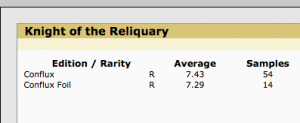Are you a Quiet Speculation member?
If not, now is a perfect time to join up! Our powerful tools, breaking-news analysis, and exclusive Discord channel will make sure you stay up to date and ahead of the curve.
It's Too Early to Review These Set Reviews!

To start with, I’d like to lead by saying that most of the spoilers have been pored over by a plenitude of speculators, investors, traders, dealers and writers. If you haven’t read the rest of the QS content for the last couple weeks, I definitely recommend it. Both the new and the old names on the site have put forward some excellent points, and it looks like the inevitable rotation has kicked our creative juices into high gear.
To rehash: Zombies is obscene, Abrupt Decay is damn good but probably best in Legacy, new angel seems solid but expensive, Rakdos's Return is probably less playable than I think, and Snapcaster Mage has the potential to be totally awesome.
Just to cut off the urge to run to eBay, this doesn’t mean his price is going up much, if at all, but the utility of flashing back Dreadbore, Abrupt Decay, Mizzium Mortars, Unsummon, new super Unsummon, Counterflux, any and all charms... there seem to be a wealth of opportunities for our friend Tiago to shine. Sadly he already commands a high price for a rare and already sees Legacy play, so it seems unlikely that his price will see a significant enough jump to be worth putting real live money into.
Nevertheless, if I’m right, I recommend trading for them because of their liquidity and heavy standard play. If I’m wrong, even with a slight drop he remains a strong long term investment.
On a related note, don’t trade the foils away. I have high hopes for their value in the future. Legacy hard to find foils don’t drop in value regardless of playability, and highly played ones get obscenely high far more quickly than you’d think.
Herein Lies the Rub
Let’s talk for a minute about trading, however, and how to approach it in a world with increasingly prevalent technology. I don’t know about you, but I’ve noticed an alarming (for me) trend concerning the increase of smartphone trading over time. I recently spent some time at SCG Open Minneapolis, and almost three times as many trades I made involved a phone as didn’t. As a person who makes his money by inches, this is horrifying. As such, I’ve been working my patootie off trying to come up with a workaround.

Unfortunately, the most consistent method seems to also be the most difficult. My next project will necessarily have to be a cross referencing of prices via different sites, and a construction of the ratios between buylist values and price determinators like Apathyhouse.com, which is a favorite of the MOTL crowd, and the semi rationally priced magiccards.info.
Don’t get me wrong, I’m in favor of universal knowledge as a general rule, but these sites cause a lot of problems in trading.
Too often the trade comes down to dimes and quarters over the course of many minutes, and only rarely is it worth the time it took to a probably fair conclusion. For those of you who haven’t dealt with this, here’s what typically occurs: One or the other of you shows interest in trading, and the search begins. A collection of cards lies on the table and what would normally would be a few minutes spent hashing out a hypothetically small trade is instead an ordeal as your trading partner looks up each magiccards.info value on his smartphone’s mind numbingly slow internet.
Can You Tell I'm Spiteful?
Trades will typically fall into two categories - a trade worth money and a trade that’s really not. The first are your trades for multiple Legacy pieces, a couple of duals, a large stack of Standard staples. The second is a couple of interesting cards, the majority of which aren’t worth much. You might need that one Woodland Cemetery for your deck, or he might want your foil Lich-lord of Unx for an EDH deck. While this is what I advocate making your trading strategy based around if you intend to grind for value, it’s also the area of trading where smartphone trading is most abrasive to me.
It would seem at first glance that this is ridiculous. Why should I care when the stakes are so low? Why not be more irritated when the trade is for Wasteland? A playset of LEDs? With so much money on the line, it must be frustrating to see their undervalued dual jump in price by 20 dollars as their phone obnoxiously points out their mistake. Simply put, you can’t know everything. Sadly, my knowledge of Legacy prices isn’t perfect - very few people could make the claim that theirs was, and fewer still could back it up.
As such, I’m far more worried about losing money than I am making it in that particular field. Think about this from a logical perspective - if all bets are off, you have chances to make or lose money on mispriced cards. If every card’s value is known information, what’s there to lose? No matter what, you can trade for strange unknowns, safe in the knowledge that if all else fails, you can use eBay closed auction values and be happily secure.
I actually try to make Legacy trades as even as possible, since they’re the ones people watch, and those are the values I’m expected to know. In addition, those are the ones that hurt the most when they go wrong, so the 20 dollars I might make is quite bad for business.
People remember when you try to take advantage of them, and just as much when you try hard not to. Instead, since Standard trades are where I make my money, the problems smartphone trading cause are irrefutably frustrating
What Is This? Econ Class? LAAAAAAAME.
A high profile high end card like Taiga will see dollar values on eBay, in stores and on price compilers. The differences between prices will be consistent - you can always depend on an eBay price lower than the compiler by a standard amount, and lower than retail by another consistent number. Because price matters so much, and the value is higher, prices are forced to standardize to conform to expectations and demands.

Contrarily, the same thing that makes low value Standard cards easy targets for grinders simultaneously make them hair wrenching to trade for when the guy on the other side of the table is smartphoning.
Because of their fairly low value, people will buy them at very different prices - a slew of people willing to buy a card for 2.00 on the internet when it retails at 1.50 will bump the price by as much as 30%, an appalling difference between its true value and its short term perceived value.
Thus, the problem becomes exactly the opposite of the Legacy situation - when you win, you don’t win much, and there’s very little chance of winning. Nevertheless, there’s a chance that you’ll lose, which makes this approach difficult, erratic and aggravating.
Simply knowing your values is no longer enough, and while you can still commit to the strategy in the hopes of making your money back, even assuming every trade is as good as it could be without smartphones, the time it takes to look up all 8 cards in the trade significantly limits the number of trades you can make.
Wait... Is That... An Actual Solution? My Time Wasn't Wasted?
The first thing I’ve found is that being forceful, but not pushy, will work wonders. Unlike the use of Star City for all of your pricing needs, rarely do price compilers churn out easy to remember, stable, or even even numbers.How do you trade a card at 1.16, one at 3.72 and one at 5.08? It ends up being practically identical retail and in some cases buylist, but God forbid if the guy with the first two feels like he’s being taken advantage of for the second, at a difference of 20 cents.
This is, of course, an exaggeration, but it seems that anything over about 40 cents difference makes people squeamish, and this means that in trying to balance the scales against all probability, the end result is that I give them 30 cents instead to make them feel more comfortable.
Saying I can trade for that at 3, that at 2, that at 5, and that at 9 always made me feel like a bit of a shark. Nevertheless, I’m coming around to that way of thinking. I’ve lost more than one trade this way, but it’s becoming more and more my approach to say things like ‘I’m willing to trade at that number, but because I think the card will go down, I’ll only trade for it if I get this card too.’
I first tried to round values up and down depending on playability, but too often I would get fed up people demanding my rounded down cards for their rounded up cards, and trying to game what little system I had in place.
Oh, a Cliffhanger. How Original.
As is readily apparent, this is an ongoing process and not nearly complete. Sadly it's taking longer than I'd like to get the data I need to come to a firm conclusion, but the more of this thought process I can get out into the community the faster we can come up with an effective way to approach this problem.
I absolutely want to keep you involved in the evolution of my approach to smartphone trading and to hear what you have to say - is this as much of a problem for you as it is for me? Are there ways you approach trading in which you differ from me? How do you feel about smartphone trading, and its implications on MTG Finance?
I look forward to reading what you think in the comments and continuing my odyssey (hyuck hyuck) in the future.






In my regular group little smartphoning is done. They only tend to be used when I indicate I’m not sure of a price or the price I name amazes them (in which case I’ve turned out to be right often enough that they are starting to believe any price I name). I don’t have internet on my phone myself (I don’t see the benefit) and I also make sure to actively ask them their thoughts on prices (even when they’re not involved in the trade) to build the believe that you should get prices from memory. Usually if anything is checked it’s the high end stuff, on which I tend to have made a good estimate anyway, the profit is generally in the low end stuff they frequently ignore.
I’ve also found that the more old school traders tend to be comfortable trading without looking up prices (as a matter of pride even) while many newer traders want to check everything out of fear/inexperience.
Personally I don’t understand the hate on smart phoning. I remember the days of being the fresh, young magic player, and being sharked out of a birds of paradise and a set of howling mines because someone strongly pushed a handful of common/uncommon beasts from odyssey/onslaught on me.
Anything that keeps people from taking sick advantage of another is just fine in my book. There are also plenty of apps that speed up the process and allow you to create 2 different lists to compare in a trade. If I can show someone that my playset of is actually worth around $ on multiple sites, they’re more inclined to believe me and go along with the trade as long as I use the same pricing structure for their cards.
Then again, I do everything in my power not to have the label of someone who goes by the motto “My cards are amazing, everyone elses are crap. Therefore everyone should be taking huge losses in trades”. Because I’ve seen way too many people do that and it’s one of the things that leaves a sour taste in the new blood at shops.
can you give me some examples of those apps you mentioned ?
At my LGS we all do smartphone trades. Some of the people there are good enough that they have the prices memorized, but the rest of us use smartphones or the store, which uses TCG mid. It helps establish a baseline so that no one get completely ripped off which results in a happy environment. The big thing though, is that we don’t care if the trades are a dollar or two or sometimes five dollars off. It doesn’t matter since we’re going to be trading again someday. Or if not, oh well, since we’ve all made money on trades before.
ie I can’t find something in their binder I want for my Sublime… I’ll just give it to them and tell them that if they open up a Ajani, I need one. Other guy’s happy. He doens’t need the Ajani anytime soon and he gets an Sublime in the process. We’re both happy since the Sublime was just sitting in my binder and now I’m guaranteed a card that I can use. He gets a card he needs, right at that moment, and a few bucks difference in the process. Next time, he’ll remember and do something like give me the two Frost Titans I’m looking for trolling with for free.
I find the use of smartphones to be terriblely annoying. The biggest thing for me is how long it takes to look up cards, especially in a deal with 10+ cards. Maybe someone here at QS should develop a WIFI dampener we can fit in our trade binders 😛